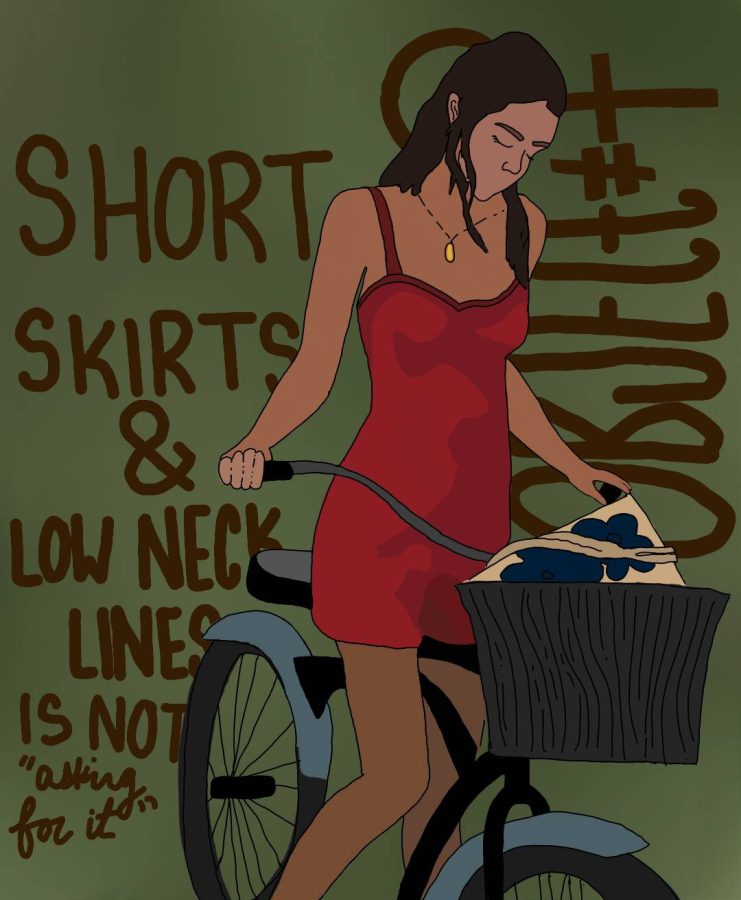Crafted by the Patriarchy: Slut Shaming
January 30, 2023
Slut shaming is something almost every female presenting person has had to deal with. You wouldn’t get that type of attention if you didn’t dress that way. I was complaining about the sexual harassment I have faced, and I was told by someone I loved that I wasn’t allowed to complain. Because of the way my tops were cut or how long my skirts were, I was silenced about harassment that I had to endure for most of my life. Although this generation works through change as efficiently as possible, old patriarchal ideas are still established through media and culture.
A notable and relevant example of this is dress codes. The National Library of Medicine defines slut shaming as “… the stigmatization of an individual based on his or her appearance, sexual availability, and actual or perceived sexual behavior.” Dress codes have been in place for centuries, and their intended purpose has always been to keep students safe and ready to learn. Social Studies teacher Micheala Nelson states,” More times than not, dress codes limit students and cause more anxiety rather than the promise of protection.” Dress codes are geared towards female bodies rather than male bodies as they determine skirt length and how low-cut a top is. In addition, those with more significant body types find themselves discriminated against more than those with skinnier body types. Dress codes are supposed to be universal and protect students, but often, they end up discriminating against the intended audience and stopping their ability to learn by perpetuating in the creation of an unsafe environment. With the constant fear of being dress coded, it is accurate to say that those with female bodies find more unease and fear when dressing for school. Is my skirt too short? Are these straps at least three fingers wide? People of color find themselves disadvantaged, as well as they have historically been hypersexualized. This is Gendered states, “Girls of color are policed much more often than white girls – even when wearing the same type of clothing. Hypersexualization of women of color probably plays into this. The same goes for bigger girls; their dressing is more likely to be deemed inappropriate or too sexy.” This fear and stress can cultivate an unaccepting and anxiety-inducing classroom environment.
Dress codes not only enforce clothing guidelines but also set up a foundation for women to hate their bodies. Math teacher Colleen Ball states, “The perceived promiscuity of a woman is more times than not judged by the amount of skin they show, which leaves us disfavored the moment we wake up in the morning and decide to wear something that makes us feel confident.” Not being allowed to be comfortable in your body because of the perceived salaciousness of one outfit is precisely what dress codes encourage. Dress codes constantly badger students into believing that their bodies distract others and make people uncomfortable: promoting hatred and discomfort when viewing female bodies. We must read between the lines to dig deeper into why dress codes exist. Dress codes exist primarily for students not to be distracted: but with how gender-biased these codes are, it is mainly for male students not to be distracted by female-bodied students. The message being sent here is that it is up to the girls to stay ‘responsible’ for their letters to their male counterparts. All of this feeds into the victim-blaming narrative that runs rampant throughout today’s society. The Sexual Assault Center of Edmonton states, “Victim blaming can be defined as someone saying, implying, or treating a person who has experienced harmful or abusive behavior (such as a survivor of sexual violence) like it was a result of something they did or said, instead of placing the responsibility where it belongs: on the person who harmed them.” Dress codes do just this; they blame the female students and enforce strict guidelines forcing them to take responsibility for any sexual harassment that may or may not occur. Dress codes also spread the message that how one dresses is how one should be treated.
Slut-shaming affects how many think and feel about their bodies and articles of clothing. With this victim-blaming narrative, many women start limiting the clothing they wear which can affect their daily lives. Freshman Laila Motiwala states, “I have realized that slut shaming has made me scared to buy certain pieces of clothing that are deemed ‘slutty’ by our society. If I wore those clothes, I would fear someone might think differently of me.” In addition to this fear of trying out new styles, the fear of self-expression is common with slut shaming. When societal standards affect one’s self-expression, individuality is gone with that notion as well. Junior Evanka Singh states, “Slut shaming affects me as it hinders my expression and has made me more afraid of my body since all the comments are so degrading.” It is important to note that it isn’t just people around us implementing this idea in us. Instead, society and the media imply that a woman’s perceived promiscuity is what defines her. Motiwala adds, “The media can have a big role in encouraging slut shaming because it has so much control over the general public. Most people will immediately agree if anyone with power in the media says anything. It is scary to think that the media can say that slut shaming is valid or okay, or that so many people would blindly follow that path .” One notable example of someone in the media encouraging slut shaming is the infamous media personality, Andrew Tate. In an interview, Tate stated, “A body count is the number one way to judge a female’s value.”
Patriarchal standards of sexual purity extend to modern times and frequently affect women. Tate’s way of thinking has spread to people, and his influence has affected the way many view women and their sexual history. It is essential to evaluate Tate’s quote. His belief that a woman’s value’ lies in their sexual history or how they dress is appaling and makes for a toxic standard that all women must stay pure or limit their sexual partners. Tates thinking can be credited to societal norms and expectations set at a young age. Different sexual standards are set for young girls and boys due to the attitude of the media geared toward them. Hip-hop artists utilize the sexualization of young women in their videos with cash and luxury cars for a young audience to aspire to have. This advertisement is geared toward young boys, emphasizing the expectation that they must have sexual prowess and power and that the women around them must be at their disposal. Sophomore Sara Cizek states, “Women have grown up being taught that if we reveal too much, no one will respect us and that once we find a good man, everything will be okay.” The difference in expectations for men and women makes it easier for people to encourage slut shaming, as it is believed that they are doing women a favor by letting them know that their behavior is ‘disrespectful.’
Although these patriarchal values are put into place long before we are born, it is essential to understand that it is possible to change these standards so young women can live without constantly examining how ‘scandalous’ their outfit is. Senior Paige Bryan states, “After seeing what my friends have gone through with slut shaming, I never want that to happen to anyone again.” As these standards are set at a young age, it is up to us to educate ourselves and help victims of slut shaming move forward. Clothing or sexual partners do not define a person or their value because everyone matters, and sex is never something to shame someone for.




